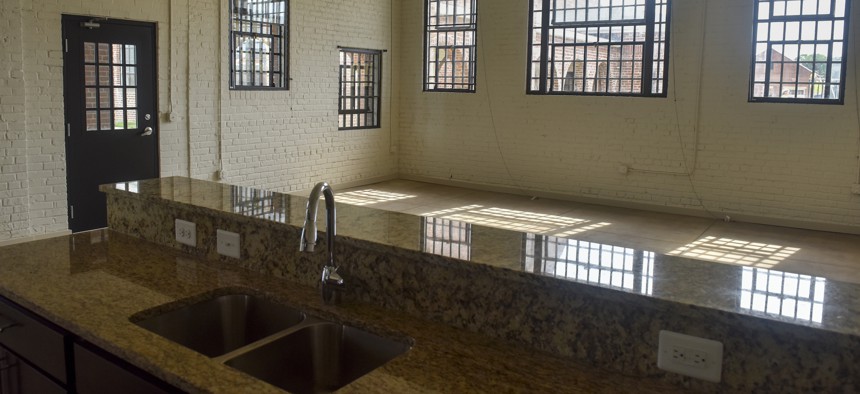Economic Development Efforts Thriving in Repurposed Prisons

Some of the units of Liberty Crest Apartments feature open layouts and the original barred windows of the Lorton Prison in Virginia on May 18, 2017. The apartment complex is part of a $188 million overhaul of what was formerly the site of Lorton Reformatory. Jahi Chikwendiu/The Washington Post via Getty Images
In recent years, former correctional facilities in seven states were converted into apartments, a sports complex, a movie studio and more, initiatives that are generating jobs and boosting local economies, according to a new report.
A movie studio, a whiskey distillery, a business park. In some communities, these enterprises are hosted in what seems like an unexpected setting: former correctional facilities.
Since 2000, 21 states have partially or fully closed prisons and other correctional facilities, and some areas have repurposed the properties in ways that strengthen communities and their local economies, according to a recent report from The Sentencing Project, which advocates for “effective and humane responses to crime” that minimize prison sentences.
A Range of Developments
In seven states–California, Illinois, Michigan, New York, Tennessee, Texas and Virginia–there are completed or planned prison-reuse initiatives, according to the report. Stakeholders in Colorado and Massachusetts are exploring uses for shuttered correctional facilities as well.
Here are examples of what four states have done:
New York. Opened in 1976, Arthur Kill Correctional Facility once had space for 931 beds. But after its closure in 2011, a production company bought the waterfront Staten Island property in 2017 and the building began its second life as a movie and television studio, the report said. The initiative created 1,311 permanent jobs, and cinephiles might recognize scenes from popular productions like Orange is the New Black and Ocean’s 8 that were filmed at the site.
Also in New York, the Mid-Orange Correctional Facility was transformed into a business park and home to a brewing company, a sports complex and hemp service provider.
Tennessee. Brushy Mountain State Penitentiary served as a correctional facility from 1896 to 2009, but today operates as a tourist attraction. A developer–who first noticed the vacant facility while cruising by on his motorcycle–worked with the county and state to transform the penitentiary and in 2013, local voters approved the conversion. The site now includes a distillery, restaurant and museum, the report said.
Virginia. Located just outside Washington, D.C., Lorton Reformatory was a 3,500-acre maximum-security prison. By the time it was decommissioned in 1997, the facility incarcerated men, women and juveniles, and included training for trades like metalworking and brick making. With guidance from citizen task forces, Lorton is now a mixed-use development, offering art exhibition spaces for professional and emerging artists, dance studios and administrative offices.
Michigan. The state is hoping for a similar fate for the Ojibway Correctional Facility, which closed in 2018 became eligible for sale two years later. The Project Gogebic Task Force–named for the county where the prison is located–is a multi-agency team tasked with identifying solutions to the economic challenges closing the prison caused. Manufacturing and cannabis industries have expressed interest in participating in the site’s redevelopment, the report said.
Reuse Considerations
The Sentencing Project report noted that there isn’t much research about the challenges and successes of decommissioning and repurposing correctional facilities. But there are lessons stakeholders can learn from the decommissioning of other public entities, it said.
Prison-closure campaigns often focus on potential cost savings, but without thorough analysis, it’s difficult to know how much money would be saved. The report pointed to the decommissioning of 350 military bases after the Cold War. The U.S. Department of Defense estimated it would save billions based on personnel reductions, but the program’s final report found that personnel were actually resigned to different positions rather than eliminated, resulting in less savings.
Other considerations involve land reuse challenges, the report said. Many correctional facilities are built on or near polluted areas and would require long-term cleanup before they could be repurposed.
Funding for repurposing initiatives can come from a variety of sources, including state and federal grants, the report said. For example, the U.S. Department of Agriculture issues rural development grants to communities with fewer than 20,000 residents. In some cases, those funds have been used to construct correctional facilities, but could be used for initiatives like community centers or health clinics.
To read the full report, click here.
Molly Bolan is an assistant editor for Route Fifty.
NEXT STORY: GOP Governors Bus Migrants to Blue Cities, but Many Exit in Red States






